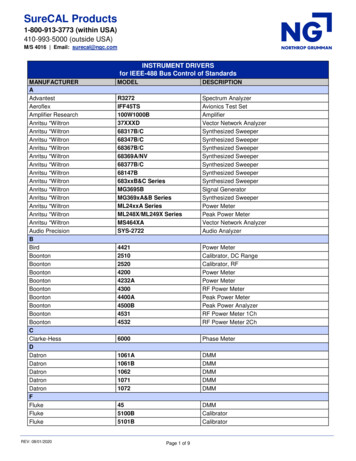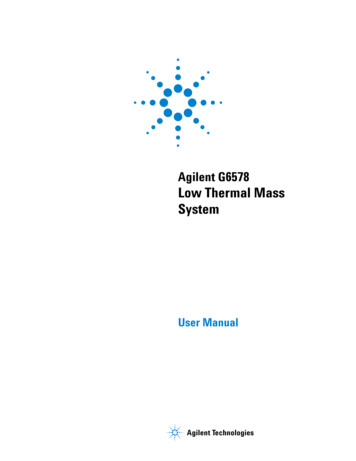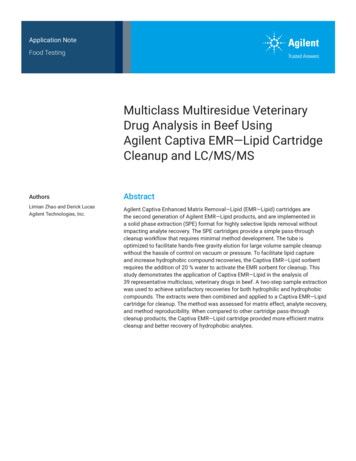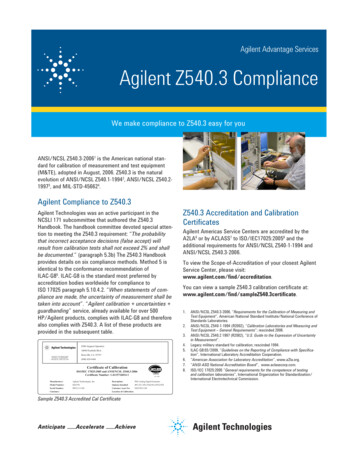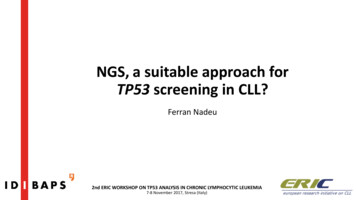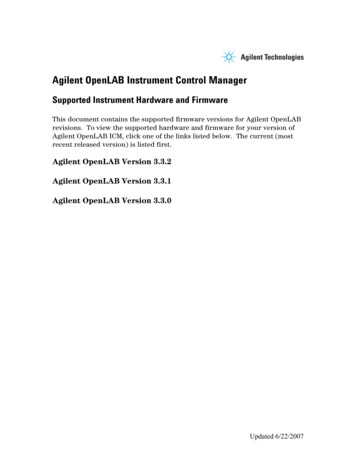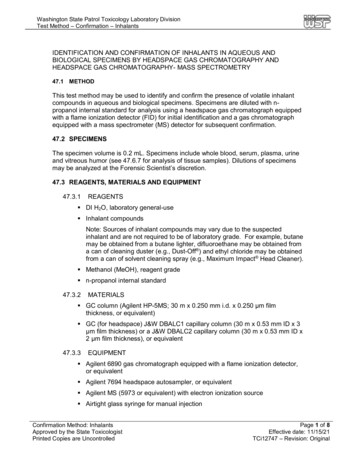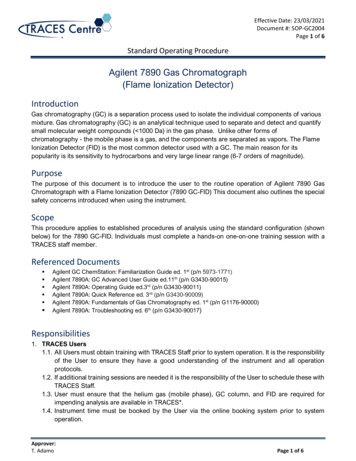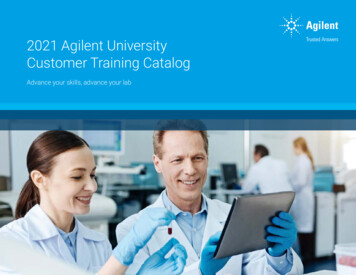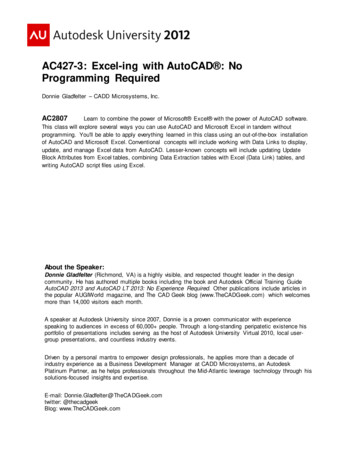
Transcription
Your Path to SuccessAgilent Solutions for Metabolomics
Understanding MetabolomicsAgilent is the leading global solution provider for measuring metabolism, offering you abroad array of cutting-edge instrumentation and innovative informatics solutions.What is metabolomics?Metabolomics is the study of endogenous metabolites, called the metabolome, which is a collection of low molecularweight (50 to 1,500 Da) compounds with a wide range of physiochemical properties. Measuring the metabolome providesimportant information about the functional status of a biological system. Its close proximity to the phenotype of anorganism provides complementary information to genomics and proteomics.What is qualitative flux analysis?Metabolomics is a powerful technique for understanding biological systems by measuring the abundance of metabolites,however, understanding is often complicated by a lack of dynamic information. Significant changes in flux througha pathway may not result in altered abundance of metabolite intermediates. Changes in flux are the result of eitherdifferences in the amount of enzyme present (for example, transcriptional levels) or activity of the enzyme (for example,inhibitors or mutations). Qualitative flux analysis highlights the relative rate of reactions using stable isotope tracing(typically containing 13C, 15N, or 2H) and results in changes in the natural isotopic pattern of downstream metabolites.Agilent metabolomics solutionsInnovative metabolomics solutions from Agilent provide a powerful portfolio of instruments and informatics tools. Acommon software platform combines the results from multiple analytical techniques, helping answer challenging biologicalquestions faster. Agilent collaborates with leading metabolomics scientists to develop next-generation solutions andworkflows to accelerate your metabolomics research.2
Metabolomics is Integral to a Variety of Research AreasBasic and clinical researchIdentify and verify metabolite biomarkers that correlate with disease states aswell as provide fundamental insights into biology.AgricultureIdentify and understand metabolic pathways to optimize crop development, yieldimprovement, and pesticide/herbicide resistance.Food and nutritionIdentify the presence or absence of metabolites that correlate with major traitssuch as food quality, authenticity, taste, and nutritional value, and aid in thedevelopment of nutraceuticals.PharmaceuticalIdentify metabolites and markers of toxicity for drug discovery and development.Environmental“Agilent’s mass spectrometrysystems combine the highacquisition speed and widedynamic range necessary toidentify and quantitate a diverserange of cellular metabolites.We can simultaneously findneedles in a haystack andmeasure the haystack.””– Amy A. Caudy, Ph.D.,The Donnelly Centre for Cellularand Biomedical ResearchUniversity of TorontoIdentify metabolites that relate to the effects of chemicals and other stressors inthe environment on a biological system.Biofuels and synthetic biologyIdentify metabolite profiles to optimize fermentation processes andbiofuel production.Systems toxicologyFind predictive signatures of toxicity in plasma and urine that can act assurrogates for evaluating the level of exposure to drugs and environmentalpollutants.3
Agilent Solutions for MetabolomicsA good sample preparation strategy is vital to generating quality results. The strategy must address quenching metabolism,lysing cells where required, and effectively extracting metabolites. This process must be tailored for the metabolites ofinterest, compatible with the analytical method, and reproducible.The sample matrix may present challenges in the analysis, including irreproducible chromatography, system fouling, andionization suppression. Proteins and lipids are two common classes of biomolecules that should be removed from thesample extract. Proteins are precipitated during quenching, and lipids are generally removed by liquid-liquid extraction.Agilent Captiva EMR—Lipid technology offers an alternative approach that both filters the protein precipitate and performsefficient lipid removal in one step. Lipids are removed based on a combination of steric hinderance and hydrophobicinteraction. Effective lipid removal significantly improves method reliability and ruggedness while reducing ion suppressionof target metabolites.Sample quenchingProtein removalLipid removalSample drying(off-deck)SamplereconstitutionManual sample preparation is time-consuming and prone to error, whichcan impact a metabolomics study. Automation can achieve consistent andreproducible results that are operator independent. Based on the Agilent Bravoautomated liquid handler, the Bravo Metabolomics Sample Prep Platform isdesigned for extracting metabolites from plasma samples.This standardized plasma sample preparation solution incorporates roomtemperature quenching and Captiva EMR—Lipid removal technology. Afterpreparation, samples are dried off-deck and then reconstituted on-deck prior toLC/MS analysis.Agilent Bravo Metabolomics Workbench software uses a form-based interfaceand requires no complex programming, allowing any user to walk up and startthe automated sample preparation. This workbench provides greater batch-tobatch consistency, more precise pipetting, and reduced variability between users.4
Discovery WorkflowDataAcquisition(GC/MS, LC/MS,SFC/MS, ��cationTargeted Workflow(Agilent METLIN PCDL,Agilent Fiehn Library)StatisticalAnalysis(Mass ProfilerProfessional)PathwayAnalysis(Pathway Architect)StatisticalAnalysis(Mass (Pathway Architect)DataAcquisition(GC/MS, LC/MS,SFC/MS, CE/MS)Agilent workflow for discovery and targeted metabolomics researchDiscovery MetabolomicsDiscovery metabolomics is the global profiling of metabolites by hyphenated MS techniques. Following separationand detection of compounds, features are found across all data files. The results are statistically analyzed, differentialfeatures are found and then identified.Agilent has developed robust workflows for performing global metabolite profiling by GC/MS, LC/MS, CE/MS, and SFC/MS,including metabolomics-specific software. MassHunter Profinder is uniquely designed to find and visualize features in asample batch. Results are then imported into Mass Profiler Professional (MPP) software for visualization and statisticalanalysis. MPP processing methods can be stored and used to automate analysis. MPP contains powerful statisticalalgorithms, mathematical models, numerous visualizations, pathway analysis, metabolite identification, and R-scripting.Targeted MetabolomicsTargeted metabolomics studies focus on quantifying specific metabolites of interest. Triple quadrupole massspectrometers are best suited for this task because of their broad dynamic range, high sensitivity, and selectivity forcompound confirmation. The results are statistically analyzed and differential features are found.The Agilent Metabolomics dMRM Database and Method enables straightforward implementation of an optimizedLC/MS/MS analysis of 219 central carbon metabolites, including organic acids, sugars, sugar phosphates, and nucleotides.The analytical method was developed in collaboration with Adam Rosebrock, PhD, from Stony Brook University. Thissolution includes a curated database with retention times, optimized MS/MS acquisition parameters, and a data acquisitionand analysis method. Exported results include metabolite names, integrated peak abundances, and CAS chemicalidentifiers for easy import into MPP for multivariate sample comparisons and pathway analysis.5
Agilent Solutions for MetabolomicsSoftware tailored to your metabolomics research needsMetabolomics researchers face challenges as studies become larger and morecomplex. Multivariate statistics are used to find differences between studygroups. However, it’s not enough to know what metabolites are differential;understanding the biological context is critical. Visualizing processed studyresults onto metabolic pathways facilitates biological understanding. Agilentoffers advanced analysis software for processing and interpreting complexmetabolomics data.In discovery metabolomics, feature extraction is the first step in the softwareworkflow. MassHunter Profinder provides targeted and untargeted batchfeature extraction for mass spectrometric data. It supports MS-only datafrom Agilent’s broad portfolio of mass spectrometers, including time-of-flightinstruments as well as nominal mass GC/MS systems. Profinder offers groupingof replicate data files, binning and alignment, chromatogram overlay, manualre-integration of compounds, and easy export of results to MPP for subsequentstatistical analysis.MPP software includes principal component analysis, ANOVA, clusteringalgorithms, correlation analysis, and class prediction, to efficiently turn largesample sets into meaningful information. Metadata can be added to the analysisto help find relationships in complex sample data. Features can be annotatedusing the built-in ID browser to match based on retention time and spectraagainst the highly-curated Agilent METLIN LC/MS database or the Agilent FiehnGC/MS library. These metabolomics-specific databases include compoundidentifiers for subsequent mapping to pathways.MPP has an intuitive visual tool for creating simple or complex processingmethods that can be stored and used to automate analysis. The ability tocreate methods is particularly useful when the same type of analysis will beperformed routinely.Mass Profiler Professional software includes correlation analysis tools, which can measurethe strength and directionality of pair-wise relationships between any two variables. This heatmap shows mass spectrometry abundance data after hierarchical clustering with the correlatedmetabolites (Arg and IMP) on the right.6Mass Profiler Professional software includesvolcano plot functionality to simultaneouslycalculate the fold change in abundancefor each mass entity as well as p-valuesignificance. These settings can be changedinteractively and the results can be viewed inboth graphical and table formats.
“Compound identification is a major bottleneck in metabolomics.To address this challenge, I am pleased to collaborate with Agilentto help develop the METLIN Personal compound database withMS/MS spectral library.”–Gary Siuzdak, Ph.D.,Senior Director, Scripps Center forMass SpectrometryGain deeper biological insightBy incorporating a pathway-centric workflow into omics experiments, scientistscan concurrently focus on the analysis, and potentially accelerate the processof discovery to biological insight. MPP's Pathway Architect module interactivelyfilters, maps, and visualizes data on biological pathways using publicly availablepathway databases such as KEGG, BioCyc, and Wikipathways. The softwaremaps metabolites, proteins, and genes onto curated pathways, graphicallyprojecting data onto pathways for interactive analysis.The experimental results from MPP are projected onto pathways where you canfilter, zoom, or select data. Pathways can be selected and a list of metabolites,proteins, transcripts and genes can be exported and used by other programs tocreate new “Pathway Directed Experiments.” For example, the protein identifiersfor a given pathway can be exported to create a targeted peptide analysis.This pathway-centric workflow speeds the route from discovery to insight andenables efficient planning and execution of the next series of experiments.Integrate metabolomics with other omicsWhile genomics, transcriptomics, proteomics, and metabolomics are in wideuse in both industry and academia, these experiments―performed alone―areoften insufficient to uncover meaningful correlations amid the high level of noiseomics experiments typically generate. Integration of data from multiple omicscan provide enough constraints to greatly improve the signal-to-noise of theanalysis. The Pathway Architect module of Mass Profiler Professional allowseither single omics analysis or joint analysis of multiple omics, enabling youto discover commonly affected pathways and aid in your ability to find reliableanswers more quickly.The KEGG pathway for purine metabolismshows nodes (teal) that representmetabolites; adjacent to the nodes are heatstrips summarizing the average differentialabundance values for the differentconditions. A teal bar along the heat stripindicates metabolite; a yellow bar indicates aresult for gene expression.7
Extend metabolomics with qualitative flux analysisAgilent VistaFlux allows you to quickly obtain information about selectedpathways and fluxes using stable isotope label tracing with mass spectrometricanalysis. Qualitative flux analysis presents multiple analytical challenges suchas mining the target metabolites, accounting for isotopologues, correctingfor naturally occurring isotopes, and visualizing the results in a biologicalcontext. MassHunter VistaFlux is designed to meet these challenges andprovides a solution for MS-only data from Agilent TOF-based high resolutionLC/MS systems.In qualitative flux analysis, a stable isotope labeled tracer (13C, 15N, or 2H) isintroduced into the biological system and results in changes in the naturalisotopic pattern of downstream metabolites. Following analysis by LC/MS, thedata is mined in Profinder using a target list derived from known metabolicpathways. Metabolites differing only in isotopic composition (isotopologues)are measured for each target compound and this information is used to trackmetabolic flux.Profinder easily exports batch results (.pfa format) to Omix Premium for pathwayvisualization and biological interpretation. Using both static and animatedpathway visualizations, experimental results are easy to communicate and it issimple to export figures for use in publication and presentations.glycolysispyruvatepyruvate decarboxylation to acetyl CoAacetyl-CoAaspartate itate(S )-malateD- threo -isocitrateTCA cyclefumarateIDH2 R172S2-oxoglutarate(R teL-glutamineglutamate biosynthesis/degradationOmix Premium visualization of the TCA cycle modified for use in a IDH2 mutant cell line study.8PATHWAYSTO lux is composed of four softwarepackages that facilitate the workflow: createand edit a target metabolite list (Pathways toPCDL and PCDL Manager), extract metaboliteisotopologue data (Profinder), and visualizeresults on pathways (Omix Premium).
GC/MS AnalysisThe Agilent 5977B high-efficiencysource GC/MSD system incorporatesan ultra-efficient electron ionizationsource to maximize the number ofions created and transferred intothe analyzer, revolutionizing singlequadrupole performance.Agilent 7000 and 7010 Seriestriple quadrupole GC/MS systemsprovide low detection limits, robustperformance, and software toolsthat make it easy to optimize yourmethods.The Agilent 7200B GC/Q-TOF systemdelivers high sensitivity and selectivitywith the added value of accurate massand high-resolution data for structuralconfirmation, unknown compoundidentification and superior untargetedscreening capabilities.Agilent Fiehn GC/MSmetabolomics libraryDeveloped with Dr. Oliver Fiehn, thisis the largest commercially availableand growing metabolomics-specificlibrary, containing searchable GC/MSEI spectra and retention-time indicesfrom approximately 1,437 commonmetabolites. The library comes withcomplete, preprogrammed GC/MSmethods, and documents for GC/MSmetabolomic analysis to maximizeresearch success.MassHunter Qual supports featureextraction of Agilent GC/MSD filesusing the "Find by ChromatographicDeconvolution" algorithm. Featureextracted peaks are matched to theAgilent Fiehn GC/MS MetabolomicsLibrary for identification.9
LC/MS AnalysisAgilent 6200 Series accurate-massTOF LC/MS systems provide theability to identify both small moleculesand large biologic compounds withhigh resolution, accurate massanalyses data for maximum value inqualitative assays.The Agilent 6500 Series accuratemass Q-TOF LC/MS brings the powerof accurate mass MS/MS to providestrong confidence in identifying,screening, profiling, or quantitation incomplex samples.Agilent METLIN Personal Compound Database and Library containapproximately 80,000 compounds, including 39,000 lipids and 11,800metabolites with curated MS/MS spectra. Used with TOF and Q-TOF data,identification is enabled using accurate mass and/or retention time databasesearching. Matching MS/MS data to the spectral library provides moreconfident metabolite identification.10Agilent 6400 Series triple quadrupoleLC/MS systems provide triplequadrupole performance for superiorsensitivity, renowned reliability, andoverall system robustness.Agilent InfinityLab Poroshell 120HILIC-Z columns allow retentionof polar metabolites using MScompatible solvents. The innovativecolumn chemistry provides superiorretention of polar metabolites andis stable at both low and high pH.For metal-sensitive metabolites,InfinityLab Deactivator Additive canbe used to improve detection andpeak shape.
A new window into cell metabolismMeasuring functional metabolism in live cells and determining the metabolicphenotype provides a powerful guide for metabolomics experimental design.Agilent Seahorse XF Analyzers provide a downstream approach to measuringcellular bioenergetics, enabling rapid assessment of metabolic function in livecells under multiple conditions.Determining the effects of chemical or genetic manipulations on cellularmetabolic function quickly and easily yields complementary data that addsefficiency and direction to metabolomic research.Metabolic rates in minutesSeahorse XF Analyzers measure the activity of the two major energy-producingpathways of the cell – mitochondrial respiration and glycolysis – in live cells,in real time.Seahorse XF Analyzers feature automated compound addition, solid-statefluorescence sensors in a disposable microplate cartridge, and software thatautomatically calculates and analyzes metabolic parameters.The Seahorse XF Cell Energy PhenotypeTest provides a high-level assessment ofmetabolic state and pathway preference,delivering results in under an hour.Seahorse XF assay kits and reagents specifically developed for pathways, suchas oxidative phosphorylation, glycolysis, and fatty acid oxidation, enable you tofurther interrogate and analyze cell function with same-day results.Seahorse XF analyzers are available in 96, 24, and 8-well formats to accommodate a range ofthroughput and sample needs: adherent and suspension cells, cultured or ex vivo samples, modelorganisms, and isolated mitochondria.11
Learn more:www.agilent.com/chem/metabolomicsFind a local Agilent customer center:www.agilent.com/chem/contactU.S. and Canada1-800-227-9770agilent inquiries@agilent.comEuropeinfo agilent@agilent.comAsia Pacificinquiry lsca@agilent.comFor Research Use Only. Not for use in diagnostic procedures.This information is subject to change without notice. Agilent Technologies, Inc. 2019Published in the USA, April 1, 20195991-7069EN
This process must be tailored for the metabolites of interest, compatible with the analytical method, and reproducible. . Agilent Captiva EMR—Lipid technology offers an alternative approach that both filters the protein precipitate and performs . The Agilent Metabolomics dMRM Database and Method enables straightforward implementation of .
